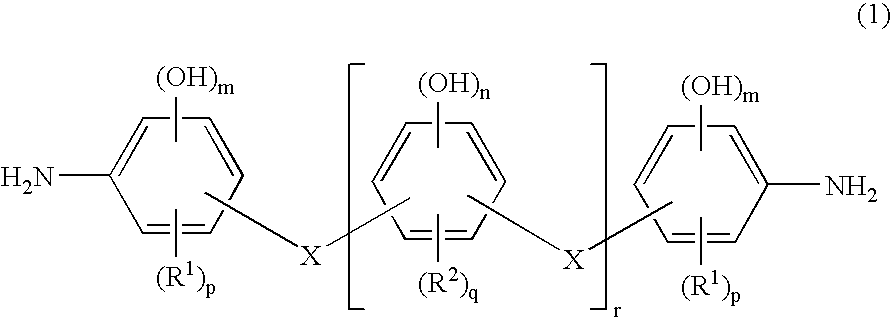Photosensitive resin composition capable of being developed with aqueous developer and photosensitive dry film resist, and use thereof
a technology of resin composition and dry film, which is applied in the direction of photosensitive materials, instruments, photomechanical equipment, etc., can solve the problems of insufficient use of polyimide film performance, inability to sufficiently use polyimide film performance, and inability to form holes and the like, so as to avoid the deterioration of parts and improve the effect of properties
- Summary
- Abstract
- Description
- Claims
- Application Information
AI Technical Summary
Benefits of technology
Problems solved by technology
Method used
Image
Examples
example 1
[0449] As materials for the polyimide resin having a hydroxyl group, there were used: (2,2′-bis(hydroxyphenyl)propanedibenzoate)-3,3′,4,4′-tetra carboxylate dianhydride (ESDA); diamine represented by the following formula
[0450] 2,2′-diaminobisphenol A (DAM-1 (commercial name) produced by Gun Ei Chemical Industry Co., Ltd.); and silicondiamine (KF-8010 (commercial name) produced by Shin-Etsu Chemical Co., Ltd.). Note that, in the following description, 2,2′-diaminobisphenol A and silicondiamine are referred to by commercial names for convenience in description. Further, as the polymerization solvent, N,N′-dimethylformamide (DMF) was used.
[0451] 69.7 g (0.27mol) of DAM-1 and 100 g of DMF were placed in a 500 ml separable flask provided with a stirrer, and the mixture was stirred, thereby preparing a DMF solution made of DAM-1. Next, 24.9 g (0.03 mol) of KF-8010 was added to the DMF solution, and the mixture was stirred until it became even, thereby preparing DMF solution of DAM-1 a...
example 2
[0458] As materials for the polyimide resin having a hydroxyl group, there were used: the ESDA; a phenol derivative having an amino group (DAM-R1 (commercial name) produced by Gun Ei Chemical Industry Co., Ltd.) represented by the following formula
; and silicondiamine (KF-8010 (commercial name) produced by Shin-Etsu Chemical Co., Ltd.). Note that, in the following description, the phenol derivative and silicondiamine are referred to by commercial names for convenience in description. Further, as the polymerization solvent, DMF was used.
[0459] 185 g (0.27 mol) of DAM-R1 and 100 g of DMF were placed in a 500 ml separable flask provided with a stirrer, and the mixture was stirred, thereby preparing a DMF solution made of DAM-R1. Next, 24.9 g (0.03 mol) of KF-8010 was added to the DMF solution, and the mixture was intensely stirred until it became even, thereby preparing DMF solution of DAM-R1 and KF-8010. Subsequently, 173 g (0.3 mol) of ESDA was dissolved in 300 g of DMF, and the ...
example 3
[0466] As materials for polyimide, there were used: the ESDA; 2,2′-bis(3-amino-4-hydroxyphenyl)hexafluoropropane (hereinafter, referred to as bis-AP-AF) represented by the following formula
; and silicondiamine KF-8010. Further, as the polymerization solvent, DMF was used.
[0467] 76.9 g (0.21 mol) of bis-AP-AF and 100 g of DMF were placed in a 500 ml separable flask provided with a stirrer, and the mixture was stirred, thereby preparing a DMF solution made of bis-AP-AF. Next, 74.7 g (0.09 mol) of KF-8010 was added to the DMF solution, and the mixture was intensely stirred until it became even, thereby preparing DMF solution of bis-AP-AF and KF-8010. Subsequently, 173 g (0.30 mol) of ESDA was dissolved in 300 g of DMF, and the mixture was added to the DMF solution, and the resultant was intensely stirred for about one hour, thereby obtaining a polyamic acid solution. The polyamic acid solution was placed in a tray coated with fluorocarbon resin and was dried in a vacuum oven at 200...
PUM
 Login to View More
Login to View More Abstract
Description
Claims
Application Information
 Login to View More
Login to View More - R&D
- Intellectual Property
- Life Sciences
- Materials
- Tech Scout
- Unparalleled Data Quality
- Higher Quality Content
- 60% Fewer Hallucinations
Browse by: Latest US Patents, China's latest patents, Technical Efficacy Thesaurus, Application Domain, Technology Topic, Popular Technical Reports.
© 2025 PatSnap. All rights reserved.Legal|Privacy policy|Modern Slavery Act Transparency Statement|Sitemap|About US| Contact US: help@patsnap.com



